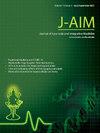Characterization and potential novel applications of zinc-based traditional medicine, Yashad Bhasma
IF 1.9
Q3 INTEGRATIVE & COMPLEMENTARY MEDICINE
引用次数: 0
Abstract
Background
Yashad Bhasma (YB), the incinerated metal ash of zinc, has been used for centuries in Ayurveda to address a variety of conditions, including eye diseases, diabetes mellitus, anemia, respiratory illnesses, etc.
Objective
This research aimed to synthesize and characterize YB and to evaluate its potential antimicrobial, antioxidant, and anti-angiogenic activities.
Materials and methods
In this study, YB is synthesized by optimizing the traditional method. Morphological and physicochemical characterization are performed using XRD, XPS, SEM, TEM, EDAX, DLS, TGA-DSC, and FTIR. The antimicrobial activity of YB is assessed using the well diffusion technique against the gram-positive bacterium Staphylococcus aureus (S. aureus) and the gram-negative bacterium Escherichia coli (E. coli). The antioxidant potential is evaluated using the 1,1-Diphenyl-2-Picrylhydrazyl (DPPH) radical scavenging assay and Nitric oxide (NO) radical scavenging assay. A chick chorioallantoic membrane (CAM) assay is performed on fertilized chick eggs to study the anti-angiogenesis potential of YB.
Results
The XRD patterns of YB showed the presence of cubic and hexagonal phases of ZnS having average crystallite size of 32.66 nm. XPS data supports the formation of ZnS phase of YB. SEM and TEM data confirmed the size of YB NPs in a range of 250–350 nm. The EDAX analysis confirmed the presence of Zn (37.2 %) and S (21.18 %). The mean particle diameter was 361 nm in DLS. TGA-DSC findings verified that the synthesized material is stable up to 435.80 °C. The FTIR confirms the presence of organic moieties in YB along with ZnS phase. YB effectively inhibited the growth of S. aureus and E. coli. The ability of YB to scavenge DPPH and NO radicals is found to be concentration dependent (50–250 μg/mL). The study also demonstrated that YB has notable antioxidant activity. The disappearance of blood vessels beneath the sample-loaded disk after 7 days indicated the effective anti-angiogenic properties of YB.
Conclusion
Altogether, YB exhibited significant antimicrobial, noteworthy antioxidant, and anti-angiogenic activities, indicating its potential as a promising therapeutic agent.
锌基传统药物的表征和潜在的新应用
在阿育吠陀中,焚烧锌的金属灰烬(YB)已被用于治疗多种疾病,包括眼病、糖尿病、贫血、呼吸系统疾病等。目的合成和表征YB,并评价其潜在的抗菌、抗氧化和抗血管生成活性。材料与方法本研究通过对传统方法的优化,合成了YB。采用XRD, XPS, SEM, TEM, EDAX, DLS, TGA-DSC和FTIR进行了形态和物理化学表征。采用孔扩散法测定了YB对革兰氏阳性菌金黄色葡萄球菌(S. aureus)和革兰氏阴性菌大肠杆菌(E. coli)的抗菌活性。采用1,1-二苯基-2-苦味酰肼(DPPH)自由基清除试验和一氧化氮(NO)自由基清除试验评估其抗氧化能力。采用鸡绒毛膜-尿囊膜(CAM)试验研究了YB对受精卵血管生成的抑制作用。结果YB的XRD谱图显示ZnS存在立方相和六方相,平均晶粒尺寸为32.66 nm。XPS数据支持YB中ZnS相的形成。SEM和TEM数据证实了YB NPs的尺寸在250-350 nm之间。EDAX分析证实了Zn(37.2%)和S(21.18%)的存在。DLS的平均粒径为361 nm。TGA-DSC结果验证了合成材料在435.80℃下是稳定的。FTIR证实了YB中有机组分的存在以及ZnS相的存在。YB能有效抑制金黄色葡萄球菌和大肠杆菌的生长。YB清除DPPH和NO自由基的能力呈浓度依赖性(50 ~ 250 μg/mL)。研究还表明,YB具有显著的抗氧化活性。7天后样本盘下血管消失,表明YB具有有效的抗血管生成特性。结论YB具有显著的抗菌、抗氧化和抗血管生成活性,是一种有前景的治疗药物。
本文章由计算机程序翻译,如有差异,请以英文原文为准。
求助全文
约1分钟内获得全文
求助全文
来源期刊

Journal of Ayurveda and Integrative Medicine
INTEGRATIVE & COMPLEMENTARY MEDICINE-
CiteScore
4.70
自引率
12.50%
发文量
136
审稿时长
30 weeks
 求助内容:
求助内容: 应助结果提醒方式:
应助结果提醒方式:


